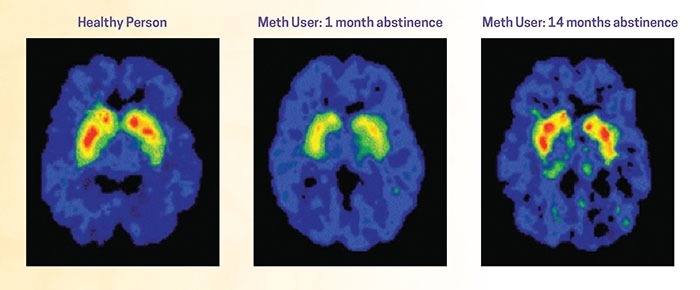Long-term methamphetamine abuse has many negative consequences, including addiction. Addiction is a chronic, relapsing disease, characterized by compulsive drug seeking and use and accompanied by functional and molecular changes in the brain.
As is the case with many drugs, tolerance to methamphetamine’s pleasurable effects develops when it is taken repeatedly. Abusers often need to take higher doses of the drug, take it more frequently, or change how they take it in an effort to get the desired effect. Chronic methamphetamine abusers may develop difficulty feeling any pleasure other than that provided by the drug, fueling further abuse. Withdrawal from methamphetamine occurs when a chronic abuser stops taking the drug; symptoms of withdrawal include depression, anxiety, fatigue, and an intense craving for the drug.43
In addition to being addicted to methamphetamine, people who use methamphetamine long term may exhibit symptoms that can include significant anxiety, confusion, insomnia, mood disturbances, and violent behavior.47 They also may display a number of psychotic features, including paranoia, visual and auditory hallucinations, and delusions (for example, the sensation of insects creeping under the skin).48 Psychotic symptoms can sometimes last for months or years after a person has quit using methamphetamine, and stress has been shown to precipitate spontaneous recurrence of methamphetamine psychosis in people who use methamphetamine and have previously experienced psychosis.49
These and other problems reflect significant changes in the brain caused by misuse of methamphetamine. Neuroimaging studies have demonstrated alterations in the activity of the dopamine system that are associated with reduced motor speed and impaired verbal learning.6,7,8 Studies in chronic methamphetamine users have also revealed severe structural and functional changes in areas of the brain associated with emotion and memory, which may account for many of the emotional and cognitive problems observed in these individuals.9,10,11
Research in primate models has found that methamphetamine alters brain structures involved in decision-making and impairs the ability to suppress habitual behaviors that have become useless or counterproductive. The two effects were correlated, suggesting that the structural change underlies the decline in mental flexibility.12 These changes in brain structure and function could explain why methamphetamine addiction is so hard to treat and has a significant chance of relapse early in treatment.
Methamphetamine misuse greatly reduces the binding of dopamine to dopamine transporters (highlighted in red and green) in the striatum, a brain area important in memory and movement. With prolonged abstinence, dopamine transporters in this area can be restored.
Methamphetamine misuse also has been shown to have negative effects on non-neural brain cells called microglia. These cells support brain health by defending the brain against infectious agents and removing damaged neurons. Too much activity of the microglial cells, however, can assault healthy neurons. A study using brain imaging found more than double the levels of microglial cells in people who previously misused methamphetamine compared to people with no history of methamphetamine misuse, which could explain some of the neurotoxic effects of methamphetamine.13
Some of the neurobiological effects of chronic methamphetamine misuse appear to be, at least, partially reversible. In the study just mentioned, abstinence from methamphetamine resulted in less excess microglial activation over time, and users who had remained methamphetamine-free for 2 years exhibited microglial activation levels similar to the study’s control subjects.14 A similar study found that while biochemical markers for nerve damage and viability persist in the brain through 6 months of abstinence from methamphetamine, those markers return to normal after a year or more without taking the drug.15 Another neuroimaging study showed neuronal recovery in some brain regions following prolonged abstinence (14 but not 6 months).16 This recovery was associated with improved performance on motor and verbal memory tests. Function in other brain regions did not recover even after 14 months of abstinence, indicating that some methamphetamine-induced changes are very long lasting. Methamphetamine use can also increase one’s risk of stroke, which can cause irreversible damage to the brain. A recent study even showed higher incidence of Parkinson’s disease among past users of methamphetamine.17
In addition to the neurological and behavioral consequences of methamphetamine misuse, long-term users also suffer physical effects, including weight loss, severe tooth decay and tooth loss, and skin sores.38 The dental problems may be caused by a combination of poor nutrition and dental hygiene as well as dry mouth and teeth grinding caused by the drug. Skin sores are the result of picking and scratching the skin to get rid of insects imagined to be crawling under it.38
Long-term effects may include:
- addiction
- psychosis, including:
- paranoia
- hallucinations
- repetitive motor activity
- changes in brain structure and function
- deficits in thinking and motor skills
- increased distractibility
- memory loss
- aggressive or violent behavior
- mood disturbances
- severe dental problems
- weight loss
